Why Carnivorous Plant Terrariums Are the Perfect Botanical Project
Carnivorous plant terrariums offer a unique combination of science, art, and low-maintenance gardening that makes them an ideal botanical project for enthusiasts of all skill levels. You’ll find these specialized ecosystems exceptionally rewarding as they create self-contained microclimates that support these fascinating plants without requiring daily attention. Unlike traditional houseplants, carnivorous varieties provide both functional beauty and natural pest control, trapping insects within their specialized leaves or pitchers. The transparent enclosures also make them perfect educational tools, allowing you to observe the complete life cycle and feeding habits of these remarkable species. Whether you’re a beginner looking for an captivating entry point into the plant industry or an experienced botanist seeking a new challenge, carnivorous plant terrariums deliver a satisfying blend of aesthetic appeal and botanical intrigue that few other projects can match.
10 Essential Supplies for Your Carnivorous Plant Terrarium
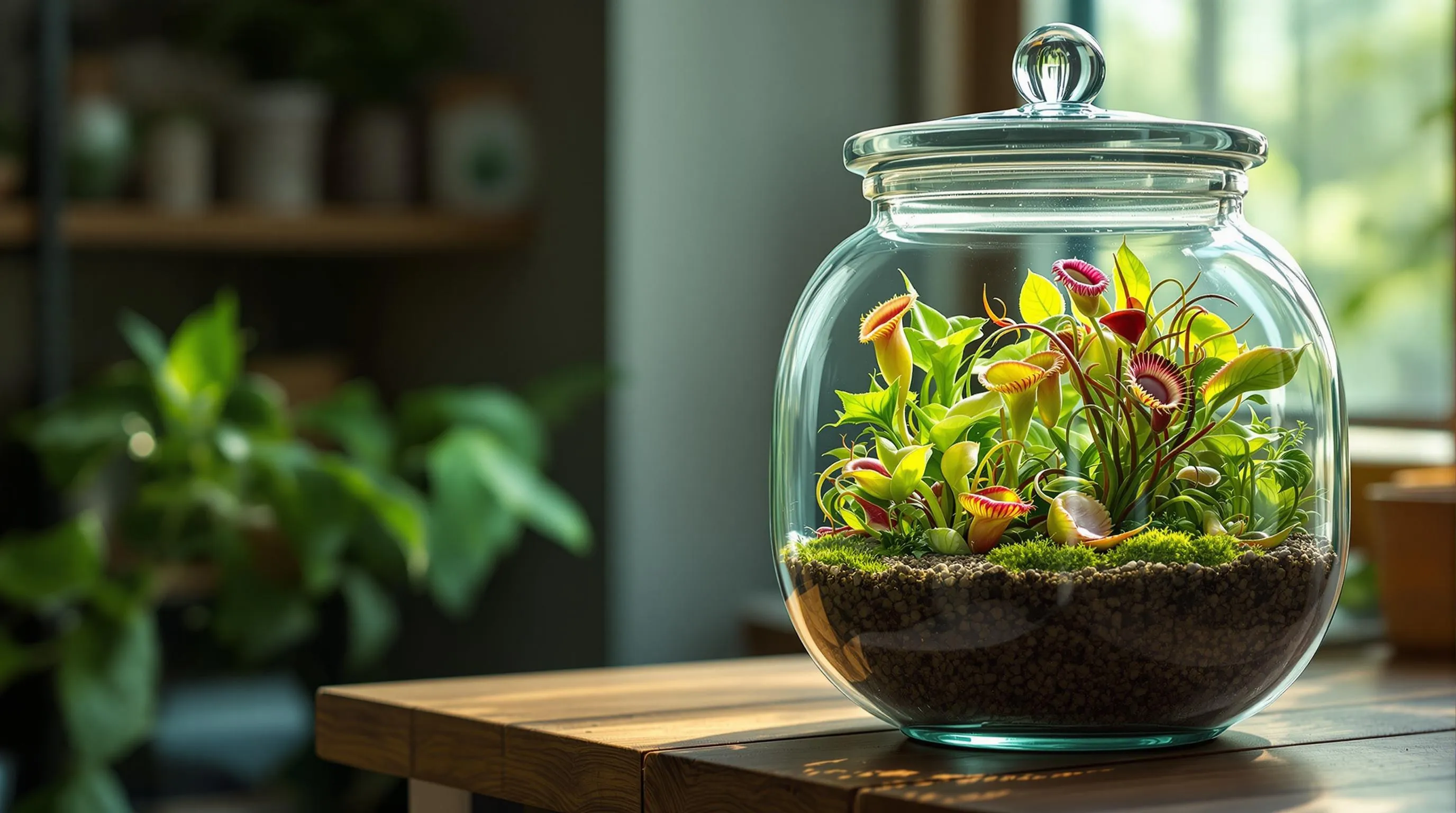
Creating a thriving environment for carnivorous plants requires exact supplies customized to their unique needs. These specialized plants demand particular conditions to flourish, and having the right equipment ensures they’ll thrive in your home.
Best Containers for Housing Carnivorous Plants
Select transparent containers that allow ample light penetration while maintaining humidity. Glass terrariums with lids work exceptionally well, offering visibility and moisture control. Aquariums, large mason jars, and specialized plant terrariums provide excellent options depending on your plant size. For smaller collections, consider repurposed glass containers like cookie jars or hurricane lamps. Ensure your container has drainage holes or a layer of gravel at the bottom to prevent root rot. The ideal container should be at least 8 inches tall to accommodate growth and provide sufficient air circulation.
Recommended Growing Media and Soil Mixtures
Carnivorous plants require nutrient-poor, acidic growing media. Never use standard potting soil, as it contains fertilizers that will kill these specialized plants. Instead, create a mixture of 1:1 sphagnum moss and perlite for most carnivorous varieties. For bog-dwelling species like pitcher plants, incorporate long-fibered sphagnum moss with silica sand. Venus flytraps thrive in a mix of 70% peat moss and 30% perlite or sand. Always use distilled water to moisten your medium, as tap water contains minerals harmful to carnivorous plants. Pre-soak all components before assembling your terrarium to ensure proper hydration from the start.
Lighting Answers for Thriving Carnivorous Plants
Provide 12-14 hours of bright, indirect light daily for optimal growth. While natural sunlight works well in east or south-facing windows, supplemental lighting ensures consistent growth year-round. Full-spectrum LED grow lights positioned 12-18 inches above your terrarium create ideal conditions without overheating. For deeper terrariums, consider installing strip lights along the sides to prevent leggy growth. Most carnivorous plants require 30-50% more light than typical houseplants, so invest in adjustable lighting systems that can be modified as your plants mature. Timer-controlled setups maintain consistent light cycles, stimulating proper dormancy periods essential for long-term health.
The Venus Flytrap Showcase: Creating a Statement Terrarium
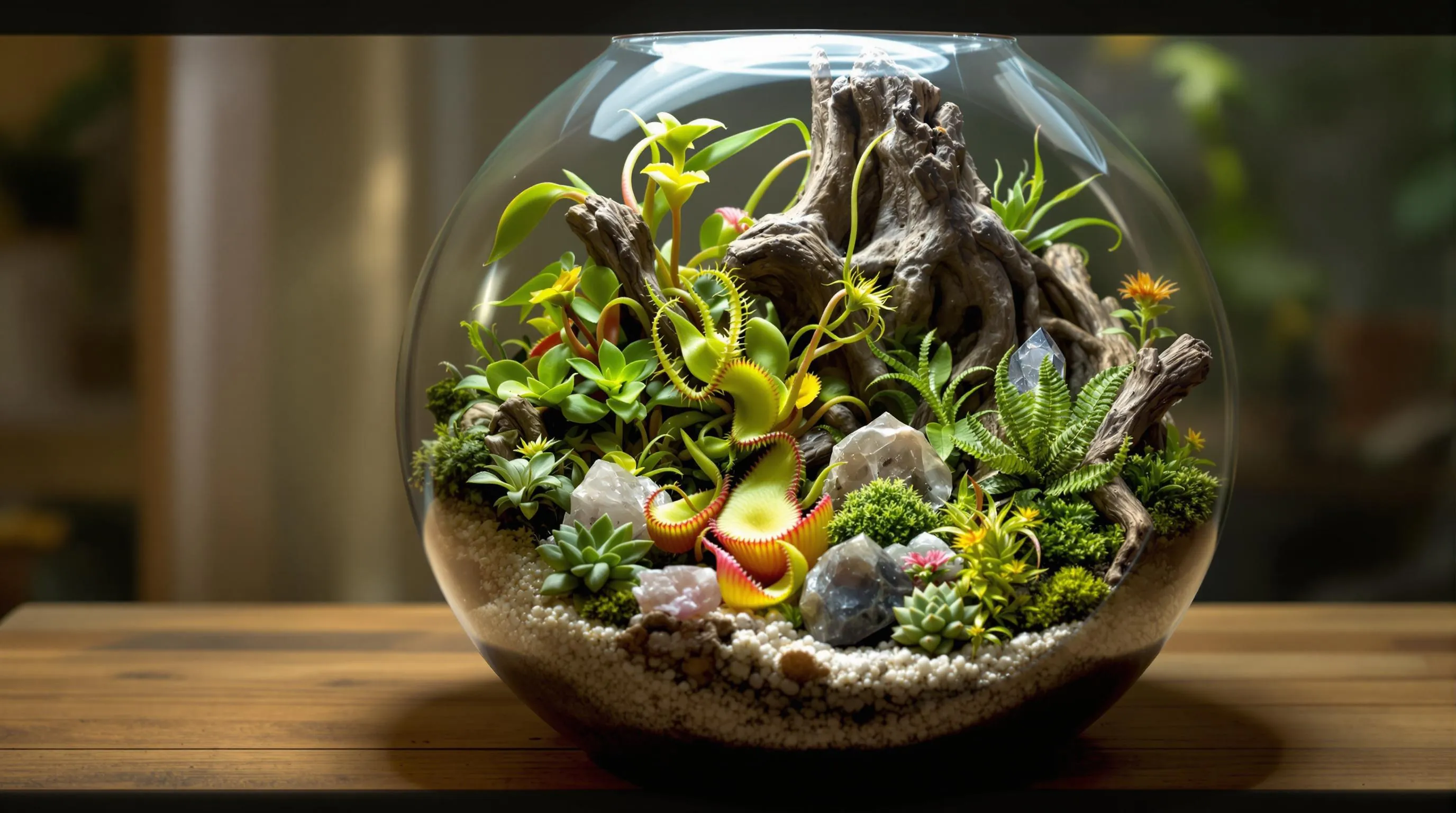
Venus flytraps (Dionaea muscipula) make captivating centerpieces for any carnivorous plant collection. Their iconic snap traps and distinctive red interiors create a dramatic focal point that instantly draws attention and sparks conversation.
Best Companion Plants for Venus Flytraps
When designing your Venus flytrap showcase, select companion plants that share similar growing requirements but offer contrasting forms. Sundews (Drosera) make excellent companions with their glistening, dew-covered tentacles that complement the structural rigidity of flytraps. Cape sundews (Drosera capensis) are particularly hardy and produce attractive pink flowers. Butterworts (Pinguicula) add a different texture with their flat, sticky leaves that form rosettes in vibrant green or purple hues. For vertical interest, consider adding smaller pitcher plants like Sarracenia purpurea that won’t overshadow your Venus flytraps. Bladderworts (Utricularia) can provide delicate purple or yellow blooms that float above the terrarium floor, adding a splash of color without competing for space.
Decorative Elements That Enhance Venus Flytrap Displays
Incorporate strategically placed elements to create a professional-looking Venus flytrap terrarium. Small pieces of driftwood or ghostwood create elevation and mimic natural bog environments while serving as climbing surfaces for vining companion plants. Quartz or clear crystals reflect light and add visual interest without altering the soil chemistry. River stones or glass pebbles in neutral colors provide drainage paths and create natural-looking borders between different plant groupings. Consider adding preserved moss (not live sphagnum) as ground cover to maintain humidity while creating a lush backdrop. For a dramatic effect, position a small terrarium spotlight to cast shadows of the Venus flytraps’ distinctive traps against the terrarium walls. Keep decorations minimal—remember that your Venus flytraps should remain the stars of the show.
Pitcher Plant Paradise: Designing Vertical Carnivorous Gardens
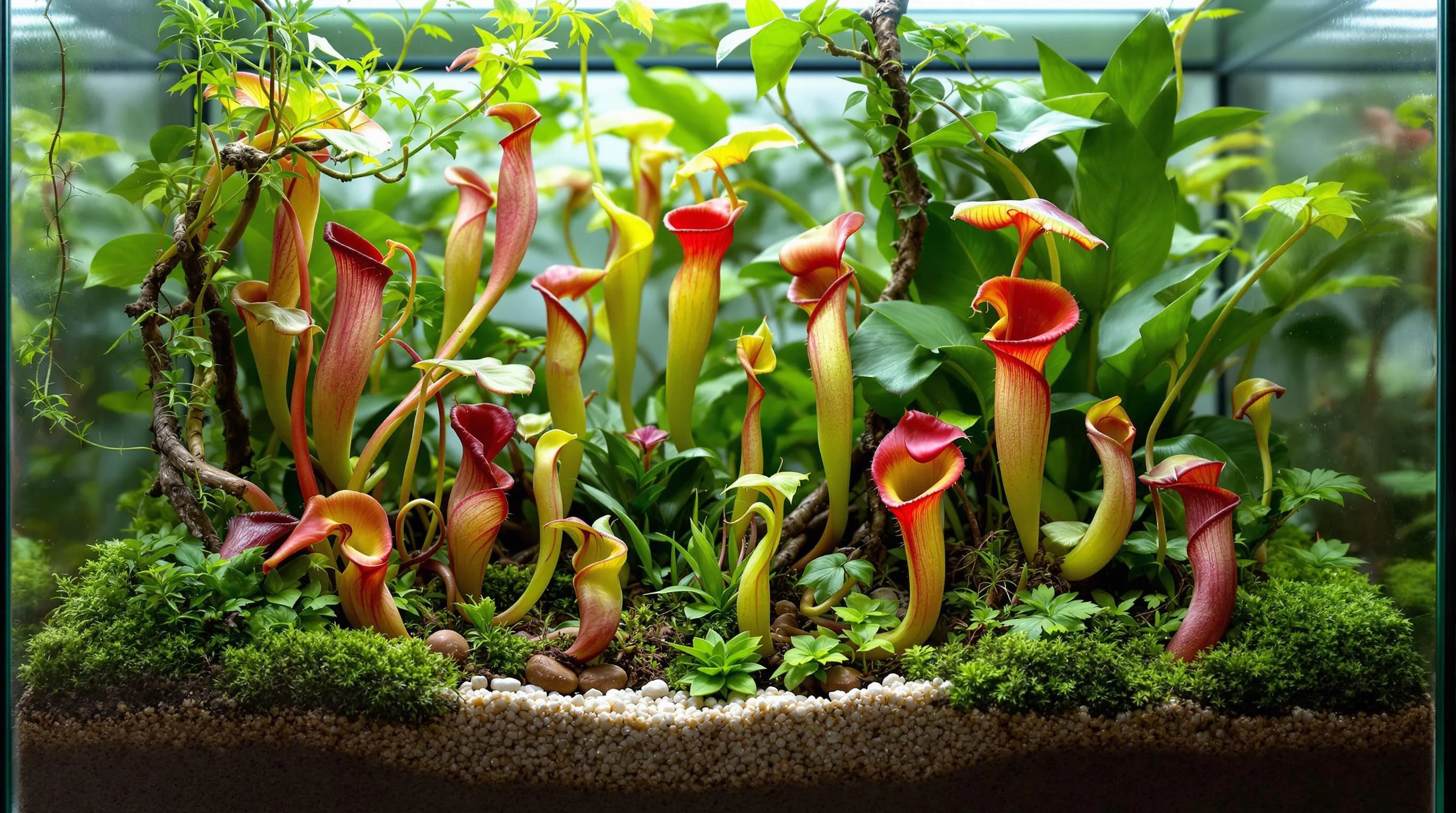
Pitcher plants offer unique opportunities to create stunning vertical displays that maximize space while showcasing their elegant hanging traps. These carnivorous beauties can transform any terrarium into a tropical paradise with their colorful, elongated pitchers dangling gracefully from vines or rising majestically from the soil.
Nepenthes Hanging Terrarium Ideas
Nepenthes, also known as tropical pitcher plants, thrive in hanging displays that allow their pitchers to develop fully. Create a dramatic suspended garden by mounting a glass orb terrarium from your ceiling, filling it with a base of sphagnum moss and perlite mix. Position your Nepenthes so its vines can cascade downward, displaying the colorful pitchers at various stages of development. For added dimension, include species with different colored pitchers such as Nepenthes ventricosa (with its vibrant red traps) and Nepenthes alata (featuring green pitchers with red speckles). Install small hooks inside taller terrariums to support climbing varieties like Nepenthes rajah, allowing them to climb naturally while developing larger pitchers. Consider adding small LED grow lights at the top of your hanging terrarium to ensure adequate lighting while creating a stunning nighttime display that highlights the translucent quality of the pitchers.
Sarracenia Bog Garden Concepts
Transform a wide, shallow terrarium into a miniature bog garden featuring North American pitcher plants (Sarracenia). Arrange taller species like Sarracenia leucophylla and Sarracenia flava toward the back, creating a dramatic backdrop with their trumpet-shaped pitchers that can reach 3 feet tall. Place shorter varieties like Sarracenia purpurea in the foreground to showcase their unique squat, vase-like traps. Add visual interest with contrasting textures by incorporating carnivorous sundews (Drosera) as ground cover between your pitcher plants. Use white silica sand to create paths through your bog garden, mimicking the natural sandy soils of their native habitats while providing striking contrast against the colorful pitchers. For authentic bog atmosphere, add small clumps of live sphagnum moss which will not only enhance humidity but also create a self-sustaining network. Consider incorporating a small water feature that maintains proper moisture levels while adding a reflective element that highlights the architectural beauty of your pitcher plant collection.
Sundew Spectacles: Designing Dewy Drosera Displays
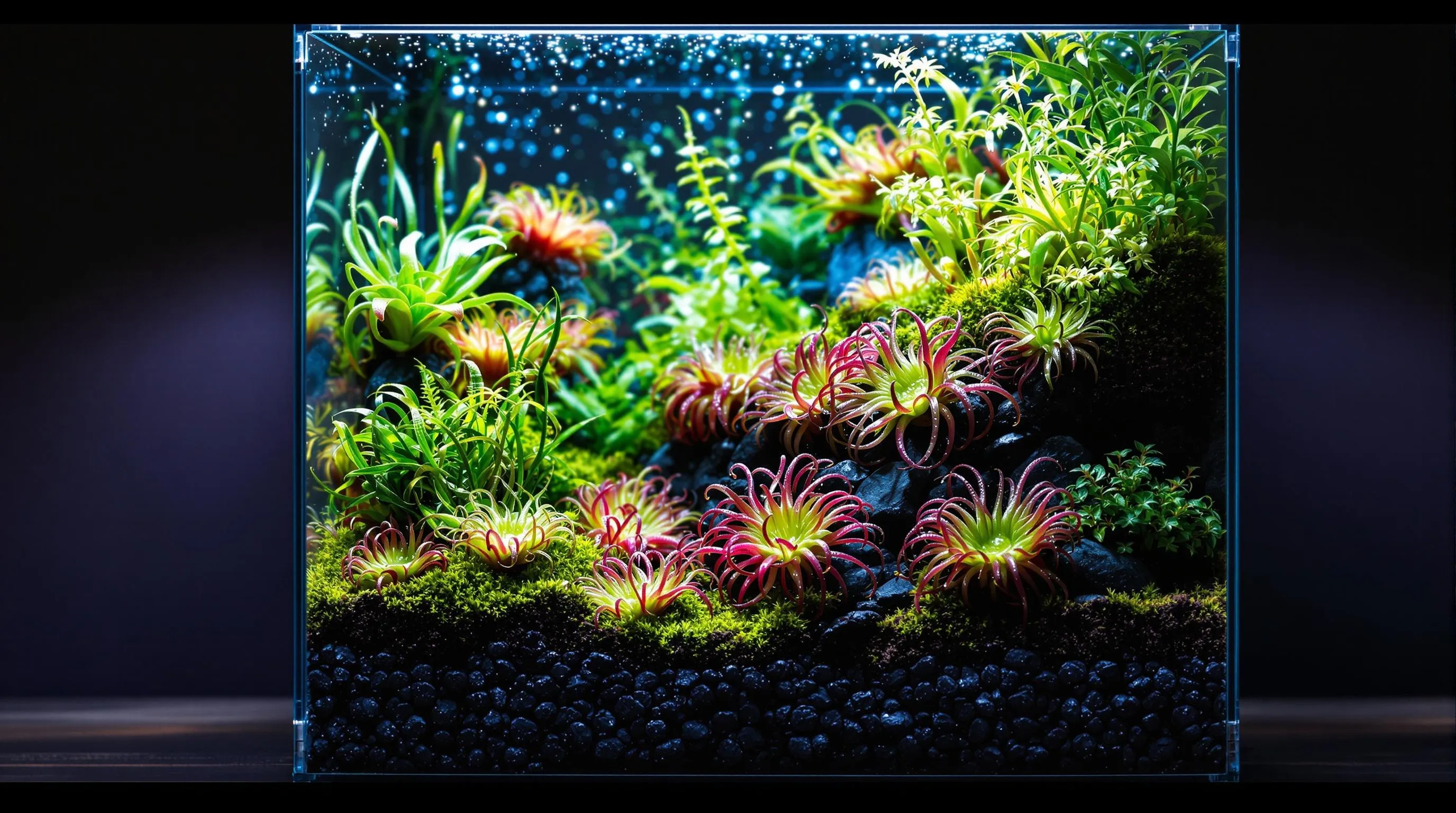
Sundews (Drosera) offer some of the most visually stunning displays in the carnivorous plant industry with their glistening, dew-covered tentacles that lure and trap insects. These fascinating plants come in various shapes and sizes, making them perfect candidates for creating eye-catching terrarium arrangements that showcase their unique beauty.
Creating Micro-Habitats for Different Sundew Species
Different Drosera species thrive in exact conditions, so designing customized micro-habitats will ensure their success in your terrarium. For tropical sundews like D. capensis and D. adelae, create a warm, humid environment with temperatures between 70-85°F. Use a deeper substrate layer (about 3 inches) of 1:1 peat moss and silica sand mix. For temperate sundews such as D. rotundifolia, incorporate a slightly cooler zone with better air circulation and a higher ratio of sphagnum moss in the growing medium. Queensland sundews (D. spatulata) excel in terraced displays where you can plant them in groups on slightly elevated areas, creating a tiered effect that showcases their rosette formation. For pygmy sundews, dedicate a small corner with shallow substrate and excellent drainage, as these miniature beauties require special attention to thrive alongside their larger relatives.
Highlighting the Glistening Dew with Strategic Lighting
The true magic of sundews lies in their dew-covered tentacles that sparkle when properly illuminated. Position your light source at a 45-degree angle to maximize the reflective quality of the dew droplets, creating a stunning jewel-like effect. LED grow lights with enhanced red and blue spectrums (5000-6500K) not only promote healthy growth but also make the digestive enzymes glisten dramatically. For an even more spectacular display, install small, directional LED spotlights around the perimeter of your terrarium, angled to highlight exact sundew specimens. Morning and evening light shows the most dramatic dew formation, so consider programmable lighting that intensifies during these periods. Dark-colored backdrop materials like black aquarium gravel or obsidian stones will create contrast, making the translucent dew droplets stand out dramatically against the background. This strategic lighting transforms your sundew terrarium from a simple plant display into a living work of art that captures attention with its sparkling, deadly beauty.
The Butterwort Collection: Minimalist Terrarium Designs
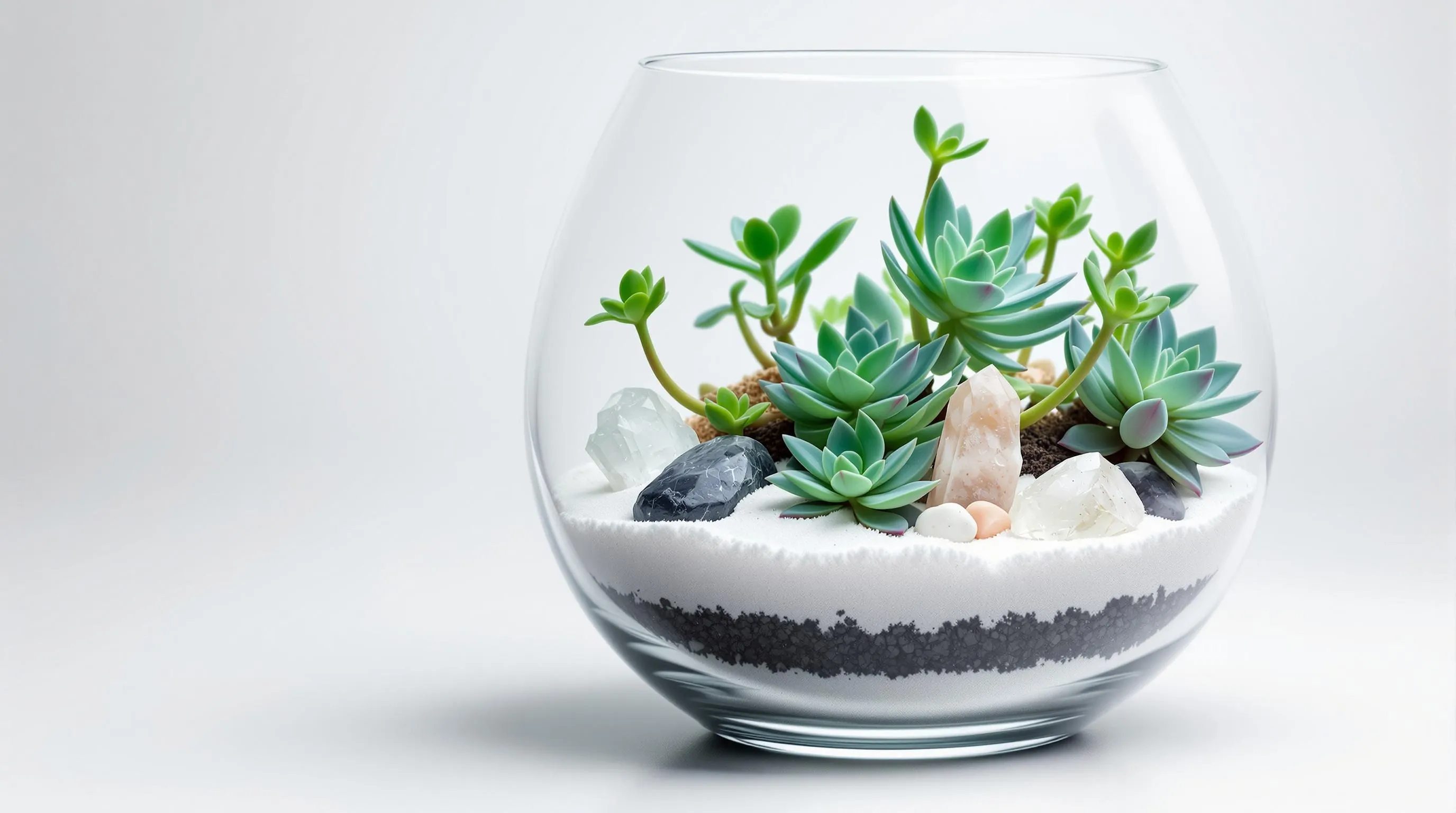
Butterworts (Pinguicula) offer the perfect foundation for creating stunning minimalist terrariums that showcase the elegant simplicity of these carnivorous plants. Their flat rosettes of sticky leaves form natural geometric patterns that complement modern design aesthetics. Create a zen-inspired display by arranging Mexican butterworts like P. moranensis or P. gypsicola on a bed of white sand, accented with small, strategically placed rocks. The contrast between the pale blue-green leaves and white substrate creates a calming visual effect while highlighting the plants’ natural architecture. For added dimension, incorporate small quartz crystals or polished river stones that won’t compete with the butterworts’ subtle beauty. Keep the container simple—a shallow glass dish or geometric terrarium works perfectly—allowing the clean lines of the plants to serve as the focal point. This minimalist approach not only showcases the unique characteristics of butterworts but also creates a low-profile display that fits seamlessly into contemporary home décor.
Bladderwort Aquatic Terrariums: Merging Water Features with Carnivory
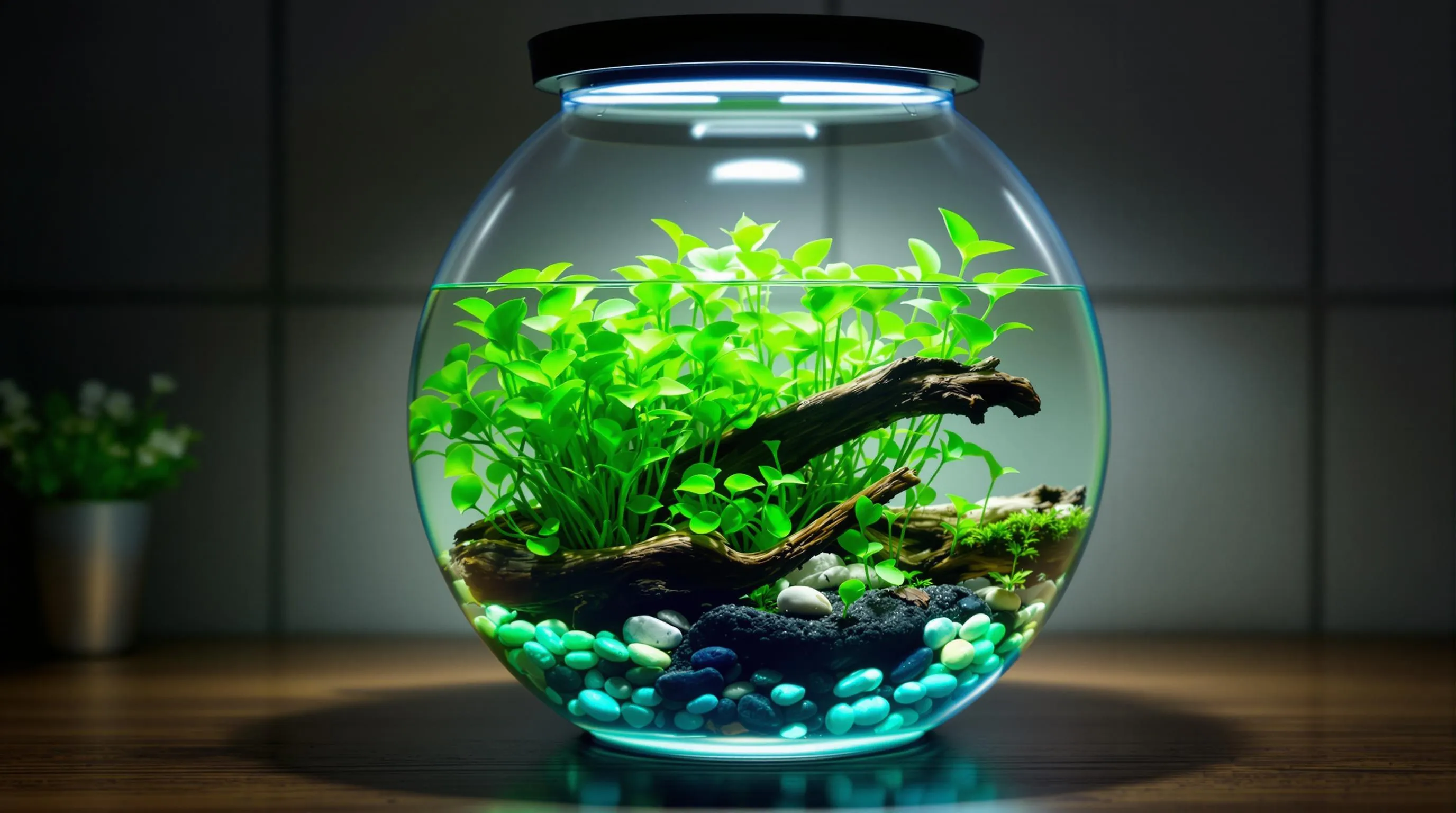
Bladderwort (Utricularia) terrariums offer a fascinating underwater carnivorous experience that’s both visually stunning and scientifically intriguing. You’ll create an aquatic network where these plants float freely, capturing tiny prey with their lightning-fast bladder traps. Start with a glass container that’s at least 2 gallons in capacity, preferably with a wide opening for easy maintenance. Fill the bottom with 1-2 inches of aquarium sand or fine gravel, then add distilled or RO water until it’s about 3/4 full. Select aquatic bladderwort species like Utricularia gibba or Utricularia vulgaris, gently placing them on the water’s surface where they’ll naturally spread. Enhance your aquatic display with small floating plants like Salvinia or dwarf water lettuce for aesthetic contrast, and consider adding decorative elements such as small driftwood pieces or aquatic-safe stones. Position your terrarium in bright, indirect light, maintaining water temperatures between 65-80°F. What makes these setups particularly appealing is their ever-changing nature—you’ll witness the delicate floating network of stems and the tiny yellow flowers that occasionally emerge above the water surface, creating a mesmerizing underwater carnivorous garden.
Cobra Lily Centerpieces: Showcasing Darlingtonia in Specialty Habitats
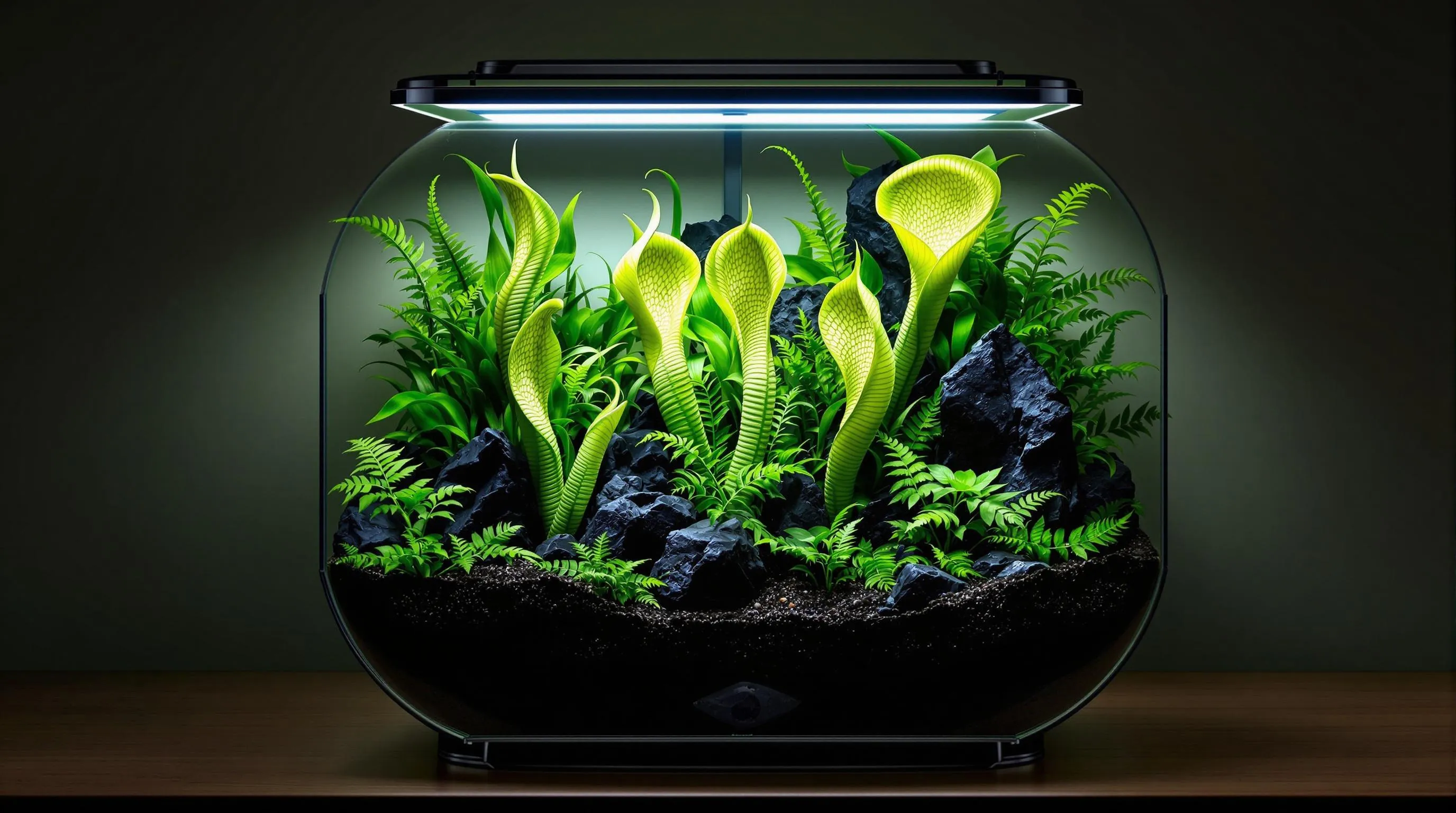
Create a show-stopping terrarium featuring the rare and mysterious Cobra Lily (Darlingtonia californica) as your centerpiece. These unique carnivorous plants require cooler root conditions than most other carnivores, making them perfect candidates for specially designed terrariums. Set up a double-container system with the Cobra Lily’s roots in a lower chamber filled with cool water while the upper portion remains at room temperature. Position 2-3 specimens at varying heights among dark, volcanic rocks to mimic their native habitats in Oregon and Northern California. Add miniature ferns like maidenhair or button ferns as companion plants that won’t overshadow your star attraction. Install a small computer fan for air circulation and use specialized LED lights with higher blue spectrum to encourage the development of dramatic cobra-shaped hoods. For an authentic touch, incorporate a slow-drip water system using a hidden reservoir to maintain consistent moisture levels without disturbing the dramatic visual impact of these prehistoric-looking plants.
Miniature Bog Gardens: Complete Ecosystem Terrariums
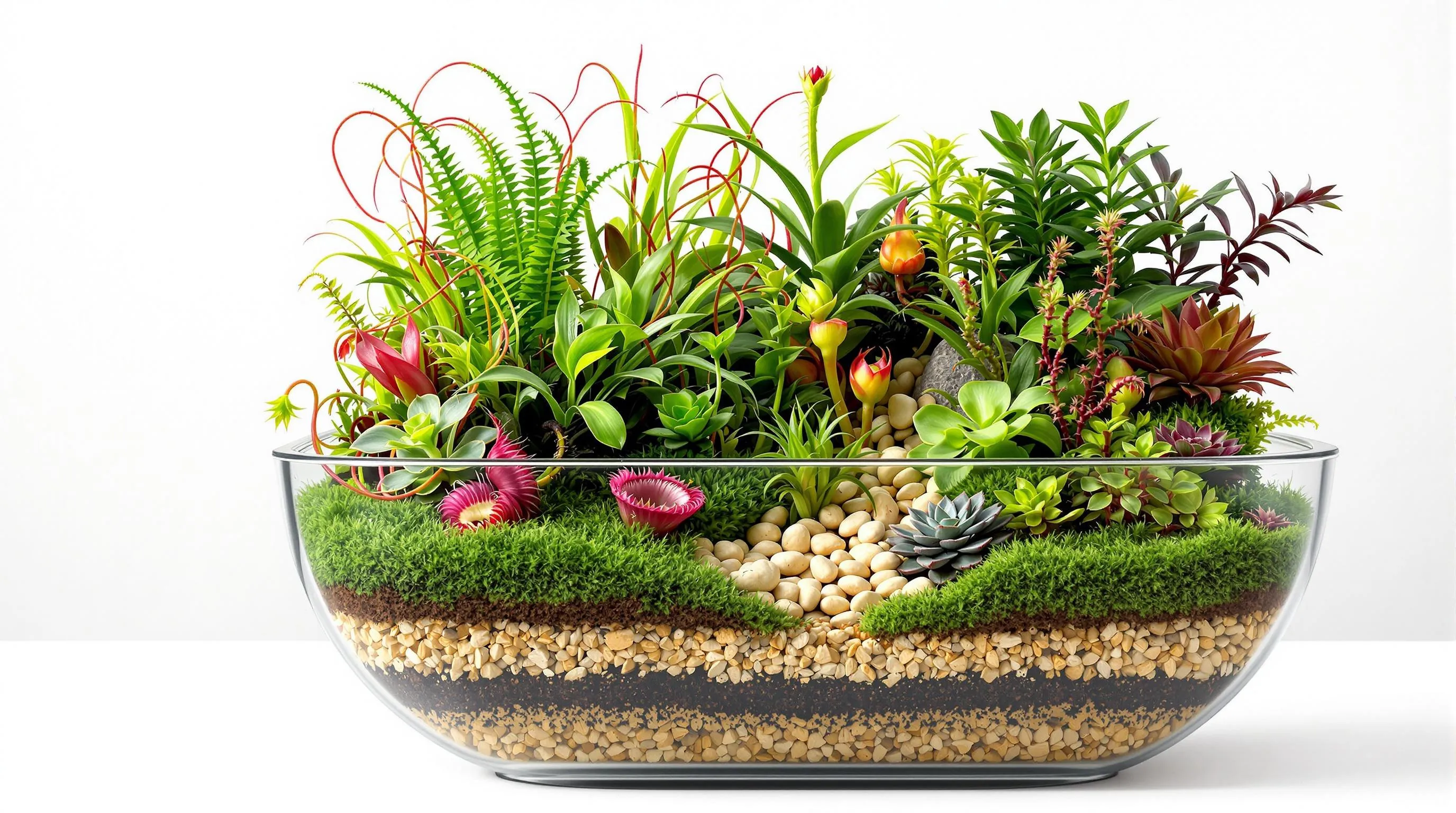
Create your own self-sustaining carnivorous plant network by designing a miniature bog garden terrarium. These complete ecosystems replicate natural bog habitats where multiple carnivorous species coexist in harmony. Start with a wide, shallow container (at least 8 inches deep) to accommodate the various root systems. Layer the bottom with small pebbles for drainage, followed by a mixture of 3:1 sphagnum moss and perlite. Arrange a diverse community of compatible bog plants, such as Sarracenia, sundews, and Venus flytraps, ensuring each has enough space to grow. Position taller species toward the back and shorter ones in front for visual depth. Add live sphagnum moss between plants to maintain moisture and create a natural appearance. Enhance authenticity with decorative elements like cranberry vines, miniature ferns, or bog orchids. These complete network terrariums not only showcase the diversity of carnivorous plants but also demonstrate the fascinating relationships within these specialized habitats, all while requiring minimal maintenance beyond regular watering with distilled water and adequate lighting.
Themed Carnivorous Plant Displays That Tell a Story
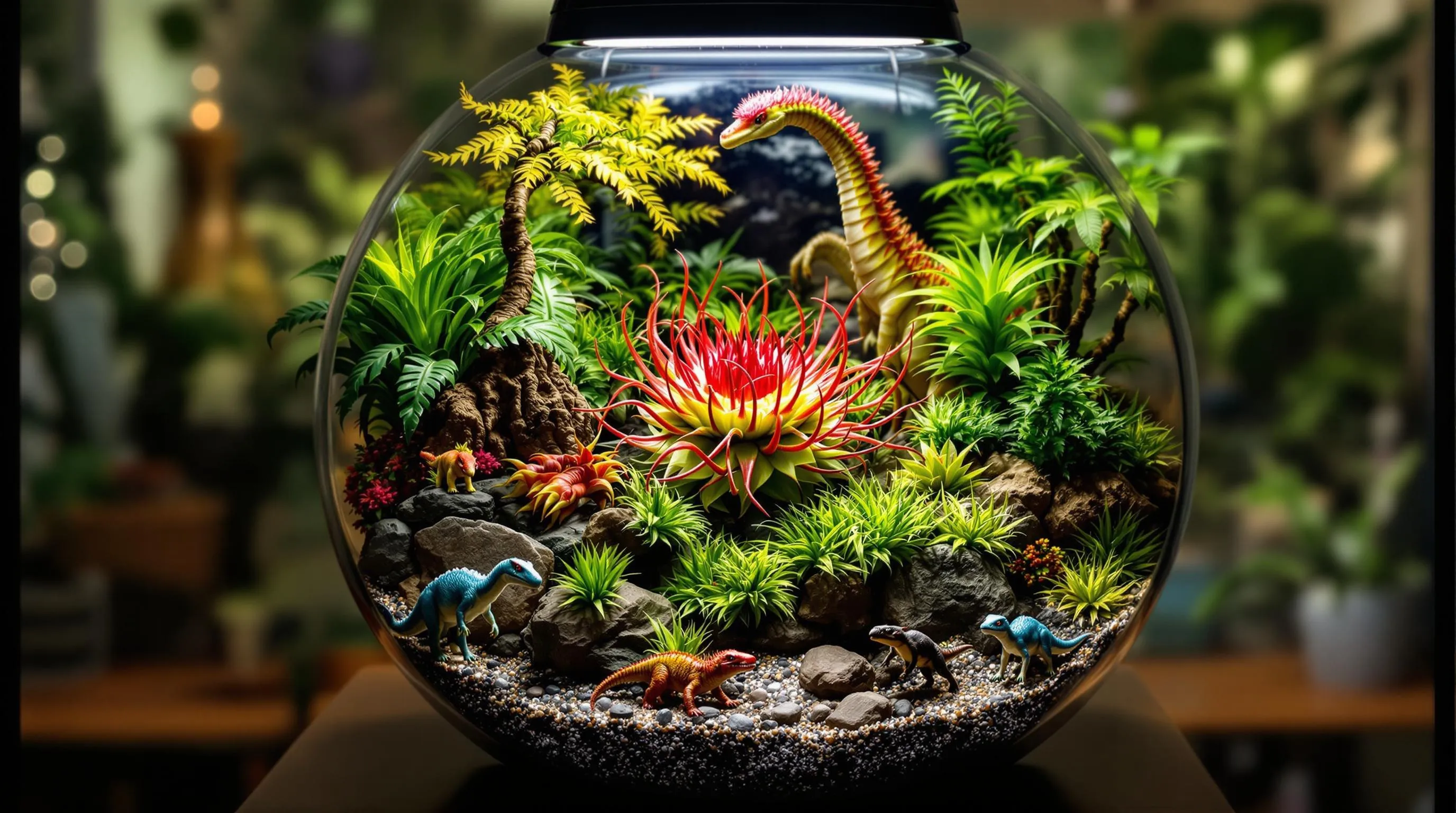
Transform your carnivorous plant terrarium into a narrative experience by creating themed displays that captivate visitors and showcase these fascinating plants in creative contexts. Themed terrariums add an extra dimension to your collection, turning a simple plant display into an immersive botanical story.
Prehistoric Carnivorous Plant Arrangements
Create a mesmerizing journey back in time with a prehistoric-themed carnivorous plant terrarium. Start with ancient-looking plants like Cephalotus follicularis (Australian pitcher plant), whose primitive appearance hasn’t changed significantly for millions of years. Arrange miniature cycads or fern varieties as companion plants to enhance the primeval atmosphere. Add small dinosaur figurines partially hidden among the vegetation, fossilized-looking rocks, and petrified wood pieces to complete the Jurassic feel. Use a darker substrate like black sand or volcanic gravel to create contrast and emphasize the primitive nature of your display. Position LED lighting to cast dramatic shadows that highlight the carnivorous plant traps, mimicking the dappled sunlight of an ancient forest canopy.
Geographic Region-Exact Collections
Showcase the incredible diversity of carnivorous plants by creating terrariums that represent their native habitats from around the industry. Develop a North American bog display featuring Sarracenia (American pitcher plants), Venus flytraps, and sundews native to the Carolinas, arranged among local sphagnum moss and pine needles. Or design an Australian-themed terrarium with Cephalotus, Drosera adelae, and other endemic species surrounded by red desert sand and eucalyptus bark. For a Southeast Asian rainforest experience, create a humid environment for Nepenthes species with small tropical accent plants and moisture-loving mosses. Each geographic collection not only educates about plant origins but also demonstrates how these unique species have evolved specialized trapping mechanisms to thrive in their exact native environments. Include small region-appropriate decorative elements like miniature flags or characteristic stones to enhance the geographic storytelling aspect.
Maintenance Tips for Long-Lasting Carnivorous Plant Terrariums
Your carnivorous plant terrarium isn’t just a display—it’s a living network that will thrive with minimal but consistent care. Monitor humidity levels weekly and mist when necessary while ensuring proper ventilation to prevent mold growth. Remember to feed your plants sparingly—they’ll catch their own prey in most cases.
Trim dead leaves promptly and check for pests monthly. When replenishing water always use distilled or rainwater as tap water can harm these sensitive species. Many carnivorous plants also benefit from a dormancy period with reduced light and cooler temperatures.
With these simple maintenance routines you’ll enjoy your captivating carnivorous display for years to come. The reward? A fascinating conversation piece that brings a touch of the wild into your home while requiring far less attention than conventional houseplants.





